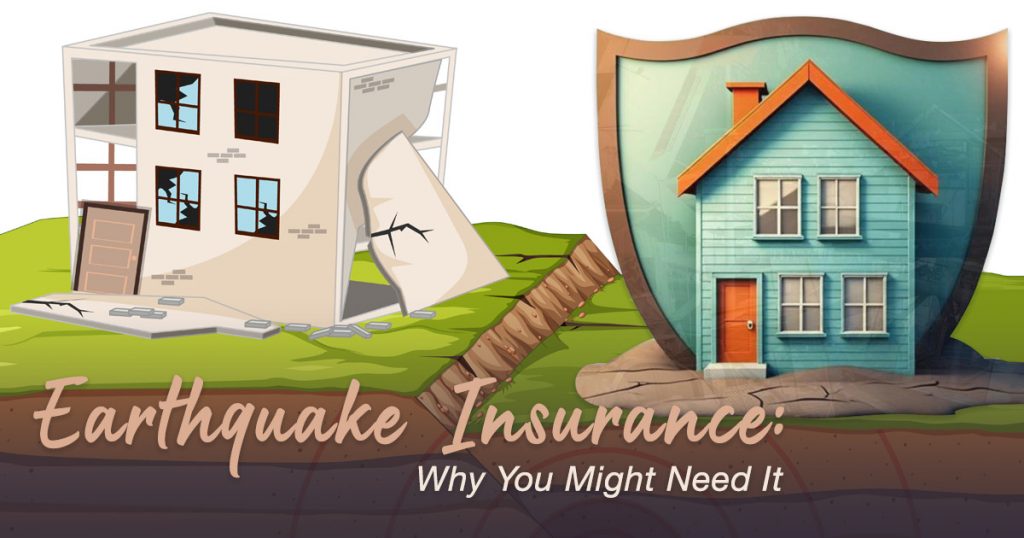Earthquakes strike without warning, shaking the ground and everything built on it. In high-risk states like California, Washington, Alaska, and Nevada, tremors happen frequently. Even if most are small, one major quake can turn a secure home into rubble within seconds.
Many homeowners assume their regular home insurance covers this kind of damage, but it doesn’t. Standard homeowners’ policies exclude earthquake losses. This leaves families responsible for repair and rebuilding costs, which can reach hundreds of thousands of dollars.
That’s where earthquake insurance comes in. It’s designed to help homeowners recover financially after their property suffers structural or total damage from a quake.
What Earthquake Insurance Covers
Earthquake insurance goes beyond patching cracks on your walls. It focuses on helping you rebuild and get back on your feet after major destruction. Policies generally include coverage for your dwelling, detached structures, personal belongings, and temporary living expenses if your home becomes uninhabitable.
For example, if your house collapses or your foundation shifts, your dwelling coverage helps pay for repairs or even a full rebuild. Personal property protection covers damaged furniture, electronics, and other valuables. Some plans also include coverage for building code upgrades and emergency repairs.
What earthquake insurance doesn’t cover are things like fires, floods, and sinkholes. These fall under different policies. It also excludes damage to vehicles, landscaping, and swimming pools. Reviewing your policy carefully ensures you understand what is and isn’t protected.
Cost of Earthquake Insurance
One of the main reasons homeowners skip earthquake insurance is the price. Premiums vary widely depending on your home’s location, age, materials, and foundation type. On average, earthquake insurance costs range from $800 to $1,350 per year, but rates climb in high-risk zones.
Deductibles also work differently from most insurance types. Instead of a flat fee, they’re calculated as a percentage, often between 10% and 20% of your coverage limit. For instance, if your home is insured for $400,000 and you have a 15% deductible, you’d pay the first $60,000 in repairs.
While this may sound high, earthquake insurance can still save you from paying hundreds of thousands more if your house collapses.
Pros and Cons of Earthquake Insurance
Every major decision comes with trade-offs, and earthquake insurance is no exception. Understanding the pros and cons of earthquake insurance helps you make a more confident choice.
Pros:
- Offers peace of mind knowing you’re financially protected after an earthquake.
- Covers your home, attached and detached structures, and personal belongings.
- Provides additional living expenses if you can’t stay in your home during repairs.
- Serves as a crucial safety net in regions with frequent seismic activity.
Cons:
- Premiums can be costly, especially in high-risk states like California and Washington.
- Deductibles are usually high, requiring homeowners to pay a large portion before coverage applies.
- Coverage doesn’t include other disasters, such as floods or fires caused by earthquakes.
- Federal aid through programs like FEMA often provides limited financial help that may not cover full rebuilding costs.
How to Decide if It’s Worth It
Homeowners often ask, Is earthquake insurance worth it? The answer depends on your financial situation, risk tolerance, and where you live.
Start by checking your area’s earthquake risk through maps provided by the USGS. Consider your home’s construction, soil type, and age. Then, ask yourself how much it would cost to rebuild if disaster struck. If replacing your home would drain your savings or leave you in debt, earthquake insurance can provide essential protection.
For some, retrofitting a home to meet seismic standards may reduce premiums. Strengthening foundations or securing structures not only improves safety but may qualify you for discounts through programs like the California Earthquake Authority.
Who Needs Earthquake Insurance and How to Know If It’s Worth It
If you live near major fault lines, your risk is naturally higher. States like California, Washington, and Alaska experience frequent seismic activity, and California alone carries most of the nation’s earthquake risk. Sellers in these areas must even disclose if their home sits on a fault line.
Older houses or those built before modern seismic codes face greater risk, especially if they’re made of brick or built on unstable soil. Multi-story homes can also sustain heavier damage.
Ask yourself these questions:
- Could I rebuild my home or replace my belongings without financial help?
- Would a major quake drain my savings or push me into debt?
- Is retrofitting my home to meet current standards a better option for now?
If covering losses out of pocket seems impossible, earthquake insurance can make all the difference. Retrofitting can also help lower premiums and qualify you for discounts through programs such as the California Earthquake Authority.
Standing Firm When the Ground Doesn’t
An earthquake can shake your entire financial stability. Insurance can’t stop the tremors, but it can help you rebuild when they pass.
The premiums may seem high, but the cost of rebuilding a home from scratch is far greater. In regions where the earth moves often, being prepared is practical. Earthquake insurance ensures that when the ground gives way, your security doesn’t.
